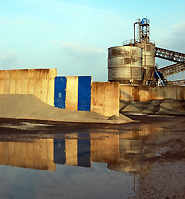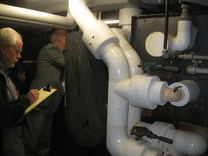|
In this issue
- Small business VOC grants to clear the air - apply this week
- Industrial Stormwater General Permit - reapply now
-
RETAP helps nonprofit save big on energy bills
- Small business architectural paint management coming near you
- Proposed amendments to NSPS for grain elevators - comments due Oct 7th
- EPA funds sustainable and innovative products and research in small business - open now

Small businesses in Minnesota
can still apply for grants up to $100,000 to reduce use of volatile
organic compounds (VOCs), with only a 10% match. Autobody, printers, dry
cleaners, platers, and gas stations have a high potential for reducing
emissions. You may recognize VOCs as fumes coming from coatings, inks,
solvents, adhesives, gasoline, and other everyday products in your business.
Deadline: August 13th,
2014
Why reduce the VOCs in your business?
-
Save money by
reducing hazardous waste disposal fees, lowering regulatory obligations, and
using fewer chemicals
-
Provide a
healthier environment for your employees and community
For more information, please
visit our website or contact
Eric David at 651-757-2218.
|
 The 2015 Industrial Stormwater General Permit will become effective
April 5, 2015, when the existing 2010 permit expires. April may seem a long ways off, but all applicants are required to re-apply for
Permit coverage or re-certify for No Exposure between July 7, 2014 and October 5,
2014. Don’t wait! Don’t be one of the facilities that could
receive penalties for applying late or not applying until after the application
deadline. Apply online (and on time!)
to avoid potential violations and penalties.
To view your previously
submitted application answers, go to the Permit Information Access Page and type in your Permit ID
number or Facility Name. Once on the
“Facility Information Menu” screen, click on the “Facility Details/Virtual
Permit Application” link.
Note: If you are applying online and accidentally get locked out of your MPCA
e-Services account, or if you have questions about your password, contact the
MPCA e-Services administrator by phone at 651-757-2728 or by e-mail at OnlineServices.PCA@state.mn.us. Note: The administrator CANNOT answer permit related questions.
If you prefer a
paper application, you can download one
at http://www.pca.state.mn.us/8393q9y (Step 5: Apply for coverage).
Click here to view
the 2015 permit. Questions? Visit the Industrial Stormwater Program website, email Stormwater Program Staff, or call the Stormwater Hotline at
651-757-2119 or 800-657-3804.
|

The
MPCA’s Retiree Environmental Technical Assistance Program (RETAP) recently
helped the Salvation Army in Minneapolis save money by reducing its use of
water and energy, leaving more money for its mission of helping those in need.
You can watch a feature on 5 Eyewitness News highlighting the project at kstp.com/article/stories/S3409796.shtml?cat=1.
RETAP
works with businesses and institutions to reduce environmental impact and
costs. RETAP conducts free energy, water, and waste audits, and provides
prioritized recommended changes and estimated financial and environmental
savings. Recommendations range from simple changes such as turning thermostats
down a few degrees in the winter or installing occupancy sensors in meeting
rooms, to larger, high-impact projects like lighting retrofits or upgrading
inefficient boilers.
Small
businesses, municipalities, churches, and schools in Minnesota can contact
RETAP to request a free audit and get suggestions for reducing their
environmental impact and costs. Contact RETAP at 612-781-1307, or visit www.pca.state.mn.us/retap.
|
Beginning November 1, 2014, collection sites for waste architectural paint from households and Very Small Quantity Generators (VSQGs) will begin opening across Minnesota, with more sites added over time. Sites will accept latex and oil-based architectural paint for recycling or disposal. The cost will be paid for by an assessment added to the price of paint; however some sites may also charge an additional fee.
Interior and exterior architectural coating products in containers of five gallons or less are accepted at a paint collection site. Go here to see which paints are acceptable and unacceptable.
Who can bring waste paint to a collection site?
Any business may dispose of its eligible latex paint or water-based paint at a collection site. For business eligibility to dispose of oil-based or other hazardous waste paint, you must:
1. Be a VSQG -generate 220 pounds or less (about 22 gallons of oil-based paint or other hazardous wastes) per month in total hazardous waste. You may accumulate up to 2200 pounds (about 220 gallons) of hazardous waste and dispose of it at one time and still be a VSQG. For more about generator size, see MPCA fact sheet #w-hw1-01, Determine Generator Size.
2. Obtain a Hazardous Waste Identification Number (HWID) before you take your architectural product waste to a paint collection site. To request an HWID at no cost, complete MPCA form #w-hw7-09, Notification of Regulated Waste Activity.
3. Keep disposal records of the waste you take to a collection site. If the site does not give you a receipt, you must keep your own records showing the date and volume of oil-based paint.
Where are architectural paint collection sites?
The goal is to have collection sites within 15 miles of a majority of the state’s population; however, building this network will take time. For collection sites in your area after November, use the Paint Drop-Off Locations tool at http://www.paintcare.org/locator/.
What about wastes not accepted by paint collection sites?
As a VSQG, you may dispose of other hazardous wastes through a VSQG Collection Program. For a list of programs in your area, see MPCA fact sheet #w-hw2-51, VSQG Collection Program Requirements. These programs require preapproval and charge for disposal of other hazardous wastes; however, the amount is usually lower than using a commercial transporter.
For regional contact information see the MPCA fact sheet on Architectural Paint Collection.
The U.S. EPA recently proposed amendments to the New Source Performance
Standards (NSPS) for grain elevators. The Clean Air Act requires grain
elevators with certain storage capacities to comply with these standards of
performance.
EPA is proposing these amendments based on its 8-year review of
the NSPS required by the Clean Air Act and in response to issues raised by the
industry related to the treatment of temporary storage. In addition, EPA is
proposing to clarify certain definitions and provisions in the existing
requirements and add a new section to the rule that with requirements only for construction,
modification, or reconstruction beginning after July 9, 2014.
The proposed new section of the NSPS would include new emission limits for certain grain elevators,
additional testing, monitoring, recordkeeping, and reporting requirements, and different compliance requirements for startup,
shutdown, and malfunction.
EPA also is proposing an additional method for determining to
which facilities the rule would apply. Storage containers at an elevator classed
as “temporary storage.”Temporary storage would be counted at about one-third of
traditional permanent storage capacity for determining rule applicability.
Comments on the proposed rule must be received on or before October
7, 2014. The proposed rulemaking can
be found at: https://federalregister.gov/a/2014-15868. Comments, identified with Docket
ID No. EPA-HQ-OAR-2010-0706, may be submitted online, by fax or regular post,
or by courier or hand delivery.
For further details or for information about
the proposed amendments, contact Bill Schrock of the EPA at schrock.bill@epa.gov.
The U.S. Environmental
Protection Agency (EPA) announced that 21 small businesses in 15 states are
receiving funding to develop and commercialize innovative, sustainable technologies
that address current environmental issues. The agency’s Small
Business Innovation Research (SBIR) program is providing $2 million in
funds to advance these innovative products and research. This year’s grant recipient is United Science, LLC in Minnesota is for Field Deployable PFCs
Sensors for Contaminated Soil Screening.
Each year, EPA provides this funding
opportunity for small businesses in a competitive two-phase process. In Phase
I, small businesses can receive up to $100,000 for ”proof of concept” of their technology.
Successful Phase I companies can apply to develop and commercialize their
technologies with Phase II funding totaling up to $300,000.
Leveraging EPA funding helps SBIR
recipients go on to bring their designs to reality, expand business, and create
products that help protect human health and the environment. Examples of previous
SBIR grantees include a company that developed a non-carcinogenic chrome
plating process, and Cambrian Innovation, which created the EcoVolt system that
treats wastewater and generates energy in the process.
Solicitation for the 2015 SBIR
Phase I awards is open now through September 11, 2014. For more information about
EPA’s SBIR Program and details on the other awards nationwide, visit: www.epa.gov/ncer/sbir.
|